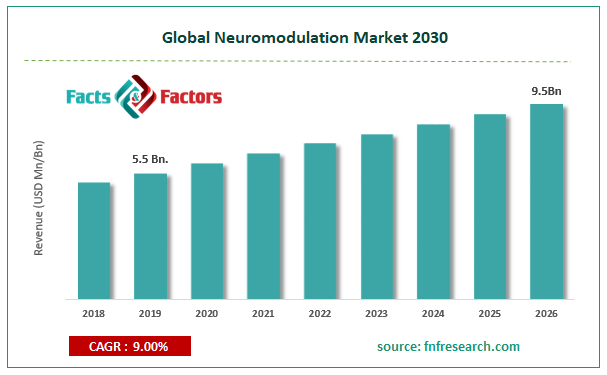 en
en  en
en  en
en  en
en 
This specialized and expertise oriented industry research report scrutinizes the technical and commercial business outlook of the Neuromodulation industry. The report analyzes and declares the historical and current trends analysis of the Neuromodulation industry and subsequently recommends the projected trends anticipated to be observed in the global Neuromodulation market during the upcoming years.

The global Neuromodulation market report analyzes and notifies the industry statistics at the global as well as regional and country levels in order to acquire a thorough perspective of the entire Neuromodulation market. The historical and past insights are provided for FY 2016 to FY 2019 whereas projected trends are delivered for FY 2020 to FY 2026. The quantitative and numerical data is represented in terms of both volume (Units) and value (USD Billion) from FY 2016 – 2026.
The quantitative data is further underlined and reinforced by comprehensive qualitative data which comprises various across-the-board market dynamics. The rationales which directly or indirectly impact the Neuromodulation industry are exemplified through parameters such as growth drivers, restraints, challenges, and opportunities among other impacting factors.
Throughout our research report, we have encompassed all the proven models and tools of industry analysis and extensively illustrated all the key business strategies and business models adopted in the Neuromodulation industry. The report provides an all-inclusive and detailed competitive landscape prevalent in the global Neuromodulation market.
The report utilizes established industry analysis tools and models such as Porter’s Five Forces framework to analyze and recognize critical business strategies adopted by various stakeholders involved in the entire value chain of the Neuromodulation industry. The global Neuromodulation market report additionally employs SWOT analysis and PESTLE analysis models for further in-depth analysis.
The report study further includes an in-depth analysis of industry players' market shares and provides an overview of leading players' market position in the Neuromodulation sector. Key strategic developments in the global Neuromodulation market competitive landscape such as acquisitions & mergers, inaugurations of different products and services, partnerships & joint ventures, MoU agreements, VC & funding activities, R&D activities, and geographic expansion among other noteworthy activities by key players of the global Neuromodulation market are appropriately highlighted in the report.
Neurological disorders such as Alzheimer's disease, epilepsy, and Parkinson's disease generally affect the central and peripheral nervous system. There are certain neurological disorders that are caused by bacterial, viral, and fungal infections as well. Thus, there is an urgent need for neuromodulation technologies to manage such disorders by using small electrodes & pulse generators to produce electrical stimulations to supplement neurological activities in subjects.
The key drivers of the global Neuromodulation market are the growing prevalence of neurological disorders and the increasing ongoing research or R&D activities for increasing the application of neuromodulation. Additionally, the growing awareness among the people regarding neurodegenerative disorders helps increase the demand for neuromodulation technologies across the globe. However, the expense of neuromodulation procedures and equipment, the stringent approval policies, and demand for the expert workforce are likely to hinder the global Neuromodulation market growth. The growing geriatric population across the globe increases the number of neurological disorders such as Alzheimer’s and Parkinson’s diseases and the surging awareness regarding the safety and efficacy of neurostimulator devices will further supplement the market growth.
The global Neuromodulation market research report delivers an acute valuation and taxonomy of the Neuromodulation industry by practically splitting the market on the basis of different technology, applications, and regions. Through the analysis of the historical and projected trends, all the segments and sub-segments were evaluated through the bottom-up approach, and different market sizes have been projected for FY 2020 to FY 2026. The regional segmentation of the Neuromodulation industry includes the complete classification of all the major continents including North America, Latin America, Europe, Asia Pacific, and Middle East & Africa. Further, country-wise data for the Neuromodulation industry is provided for the leading economies of the world.
 Report Scope
Report ScopeReport Attribute |
Details |
Market Size in 2019 |
USD 5.5 Billion. |
Projected Market Size in 2026 |
USD 9.5Billion |
Growth Rate |
CAGR 9% |
Base Year |
2019 |
Forecast Years |
2020-2026 |
Key Market Players |
Boston Scientific Corporation, Medtronic, Abbott, Synapse Biomedical, Inc., LivaNova, Nevro Corporation, NeuroPace, NeuroSigma, Neuronetics, and BioControl Medical. |
Key Segment |
By Technology, By Application, By Region |
Major Regions Covered |
North America, Europe, Asia Pacific, Latin America, and the Middle East & Africa |
Purchase Options |
Request customized purchase options to meet your research needs. Explore purchase options |
The global Neuromodulation market is segmented based on Technology and Application. By technology, the global Neuromodulation market is divided into Internal Neuromodulation and External Neuromodulation. Based on application, the Neuromodulation market is segregated into Chronic Pain Management, Failed back syndrome, Epilepsy, Tremor, Urinary, and Fecal Incontinence, Depression, Dystonia, Gastroparesis, Parkinson's Disease, Obsessive-Compulsive Disorder, Migraine, and Others.
 Some of the essential players operating in the global Neuromodulation market, but not restricted to include:
Some of the essential players operating in the global Neuromodulation market, but not restricted to include:The taxonomy of the Neuromodulation industry by its scope and segmentation is as follows:
 Technology Segmentation Analysis
Technology Segmentation Analysis Application Segmentation Analysis
Application Segmentation Analysis Regional Segmentation Analysis
Regional Segmentation Analysis

Copyright © 2024 - 2025, All Rights Reserved, Facts and Factors
 en
en  en
en